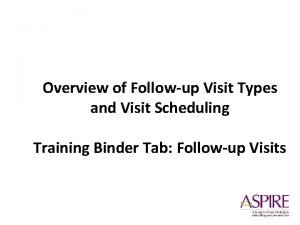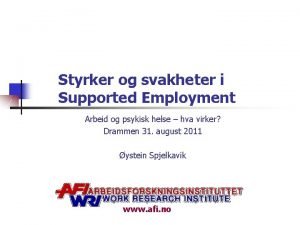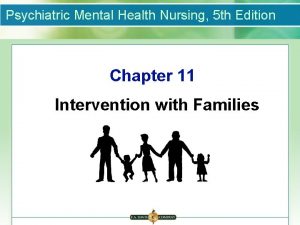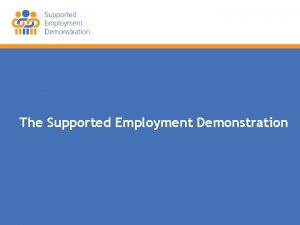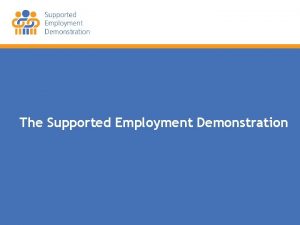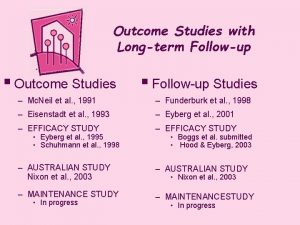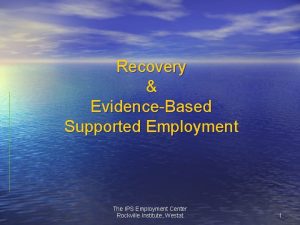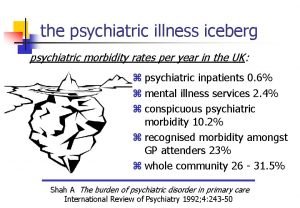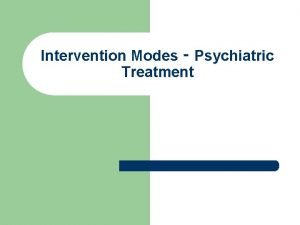LongTerm FollowUp of Supported Employment Recipients with Psychiatric


















- Slides: 18

Long-Term Follow-Up of Supported Employment Recipients with Psychiatric Disabilities Judith A. Cook, Ph. D Professor, Department of Psychiatry University of Illinois at Chicago Disability Research Collaborative Annual Research Meeting Washington, DC October 30 -31, 2014

Collaborators & Funder Jane K. Burke-Miller, Ph. D, UIC Emily Roessel, MPP, SSA This work was funded by Social Security Administration (SSA) Cooperative Agreement No. 1 -DRC 12000001 -01 -00 with Mathematica Policy Research, Inc. as part of their Disability Research Consortium under which Judith Cook was a subrecipient. Data come from the Employment Intervention Demonstration Program funded by the Substance Abuse and Mental Health Services Administration, Center for Mental Health Services Cooperative Agreement No. SM 51820. The opinions and conclusions expressed are solely those of the author(s) and do not represent the opinions or policy of Mathematica Policy Research, SSA, or any agency with the Federal Government.

Background & Objectives • A large body of research - including SAMHSA’s EIDP and most recently SSA’s Mental Health Treatment Study - has shown that evidence-based supported employment (EB SE) services substantially improve employment outcomes of people with psychiatric disabilities. • Thus, an important policy question is, does this model continue to influence employment after EBP SE services cease, and what are the duration and type of effects? • The objectives of this project are to learn more about the long-term (12+ years) impact of EBP SE on earnings, benefit receipt and benefit suspension/termination.

Employment Intervention Demonstration Program (EIDP) Personal Economy Study (PES) • The EIDP enrolled 1, 648 people with psychiatric disabilities at 8 sites in 8 states, randomly assigned them to EB Supported Employment (E) or comparison (C) conditions, and followed them from 1996 -2000. • 6 sites participated in the PES; n=867 with 505 consenting to matching and 487 were successfully matched with SSA/DAF data via Enumeration Verification System • 35 were not enrolled in SSI/DI from 1996 -2012 & another 3 died prior to 2000, yielding an analysis sample n=449 • 52% (n=234) in the E condition & 48% (n=215) in C condition

Participant Characteristics (N=449) • Average 39 years @ EIDP study baseline (2/96 – 2/98) • 52% White, 30% Black, 14% Hispanic/Latino, 4% other • 50% male • 54% schizophrenia, 27% major depression, 15% bipolar • 54% co-occurring substance use disorder • 27% less than high school education • 64% had been employed within 5 years prior to baseline • 47% reported SSI, 37% reported SSDI, 16% SSI+DI

Geographic Regions of PES Sites 19% Northeast 17% Mid-Atlantic 49% Southwest 15% Southeast

PES Participant Characteristics by EIDP Study Condition • Participants did not differ significantly by E vs C condition (univariate p<. 05) on measured background characteristics. • During the EIDP, PES participants in the E study condition had significantly better outcomes than C in terms of achieving competitive employment (56% vs 36%, p<. 001). • A higher proportion of E condition PES participants worked at all during EIDP (72% vs 63%, p=. 053). • A higher proportion of E than C worked 40+ hours in a month (58% vs 50%, p=. 076). • E condition had higher total earnings and worked more hours, than C but these differences were not significant (p>. 10).

Summary of Long-term Beneficiary Status, Mortality & Retirement Age • We examined SSA/DAF data over 13 years post-EIDP from January 2000 through December 2012 (156 months). • Participants had between 1 and 156 months of follow-up with an average (s. d. ) of 138 (39) months or 11. 5 years. • 59% were SSI beneficiaries in years 2000 -2012. • 50% were SSDI beneficiaries in years 2000 -2012. • 110 (24%) died between 2000 and 2012. • 54 (12%) reached full retirement age by 2012.

Long-term Summary Outcomes from 2000 -2012 • 32. 9% of all participants had any reported earnings. • Participants reported earning an average total of $6, 453 (s. d. =$18, 784). • 11. 8% of participants were ever suspended from SSI/DI due to work; 4. 3% ever terminated due to work; 13. 1% ever suspended and/or terminated. • Total cash benefits received = $77, 040 (s. d. =$34, 631) for SSI or dual eligible beneficiaries; $111, 841 (s. d. =48, 692) for SSDI beneficiaries. • Participants used PASS work incentive in <1% of followup months and Ticket to Work in <3% of follow-up months.

Multivariable* Analysis of Summary Outcomes • E condition did not have a significantly greater likelihood than C condition of any reported earnings over 13 years of followup (adjusted OR = 1. 27, p=. 253). • E condition was significantly more likely than C condition to ever be suspended from SSI/DI due to work over 13 years of follow-up (adjusted OR = 2. 05, p=. 024). • E condition had more total earnings than C condition over 13 years of follow-up (average approximately $3, 000 more, standardized beta = 0. 08, p=. 092). * Logistic and linear regression models adjust for effects of race/ethnicity, gender, age, education, marital status, psychiatric dx, substance use dx, medical comorbidity, psychiatric hospitalization during EIDP, and geographic region.

Long-term Longitudinal Outcomes, 2000 -2012 • There were 62, 202 monthly observations nested within 449 individuals and repeated over up to 156 months. • Individuals’ data were right-censored following program exit or mortality. • Random effects logistic and linear regression models were used to adjust for time and repeated measures correlations. • Any earnings and amount of earnings were assessed by any reported SSI or SSDI earnings. • Any suspension or termination due to work was from Mathematica DAF variable. • SSI/DI status based on monthly cash benefit paid.

Multivariable* Longitudinal Analysis: Any Earnings/Month • In multivariable* random logistic regression, E condition almost 3 times as likely as C condition to have any earnings per month (OR=2. 97, p=. 015). • This advantage was seen through 2006, or 6 -8 years post receipt of EBP SE. *Models adjust for effects of time, race/ethnicity, gender, age, education, marital status , psychiatric dx, substance use dx, medical comorbidity, psychiatric hospitalization during EIDP, and geographic region.

Multivariable* Longitudinal Analysis: $ Earned/Month • In longitudinal multivariable* random linear regression, E condition earned an average of $24 more per month than C condition (estimate = 23. 5, p=. 050). • This difference is seen through 2006. *Models adjust for effects of time, race/ethnicity, gender, age, education, marital status , psychiatric dx, substance use dx, medical comorbidity, psychiatric hospitalization during EIDP, and geographic region.

Multivariable* Long. Analysis: Suspension/Termination • In longitudinal multivariable* random logistic regression, E participants were significantly more likely to be suspended/terminated from SSI/DI due to work than C (OR=19. 74, p<. 001). • Difference seen thru 2009. *Models adjust for effects of time, race/ethnicity, gender, age, education, marital status , psychiatric dx, substance use dx, medical comorbidity, psychiatric hospitalization during EIDP, and geographic region.

Conclusions • Among the PES participants we studied, those in the EB SE condition were more likely to achieve competitive employment during the EIDP than controls. • There seems to be a clear advantage to the EBP SE condition in any earnings and amount of earnings up to 8 years post receipt of EB SE. • There is also a greater likelihood of SSI/DI program suspension/termination due to work among the EBP SE participants compared to controls.

Study Limitations • Data are from a cohort study and not a nationally representative sample. • Participants may have received vocational services post-EIDP. • Over a third (37%) were lost during the follow-up period to factors such as death, retirement, and other causes. • Our outcome measures may not capture the complicated reality of people who cycle in and out of employment and benefit eligibility over extended periods. • Our data on employment and earnings are based on self-report and therefore subject to recall and other biases

Next Steps • Look at employment and earnings data from the IRS. • Examine factors associated with the number of months of follow-up to help understand the change at 6 -8 years. • Characterize the 67% with no reported earnings during follow-up. • Identify factors other than age that predict mortality among program participants. • Focus on the 33% with any reported earnings during follow-up & look for additional patterns and predictors. • Examine work behavior around the time of full retirement age to see what is associated with continued labor force participation in that older group

Contact Information Judith A. Cook, Ph. D University of Illinois at Chicago 1601 W. Taylor St. M/C 912 Chicago, IL 60612 312 -355 -3921 jcook@uic. edu http: //www. cmhsrp. uic. edu/health/ JA Cook 10/30/14
 Followup:actionitems
Followup:actionitems Follow up visit
Follow up visit Followup edge
Followup edge Ppp loan list of recipients 2021
Ppp loan list of recipients 2021 Traer familiar command
Traer familiar command Supported employment utdanning
Supported employment utdanning Supported employment verktøykasse
Supported employment verktøykasse Thomas silverstein art
Thomas silverstein art Kernel lts
Kernel lts Ethical and legal issues in psychiatric nursing
Ethical and legal issues in psychiatric nursing Psychiatric rehabilitation
Psychiatric rehabilitation Chapter 11 psychiatric mental health nursin
Chapter 11 psychiatric mental health nursin Psychiatric services liberty hill
Psychiatric services liberty hill Development of modern psychiatric nursing
Development of modern psychiatric nursing Role of psychiatric nurse
Role of psychiatric nurse Nursing process in psychiatric nursing
Nursing process in psychiatric nursing Psychiatric nurse conference
Psychiatric nurse conference Psychiatric nursing meaning
Psychiatric nursing meaning Southern psychiatric association
Southern psychiatric association

